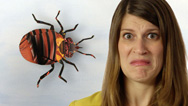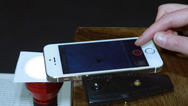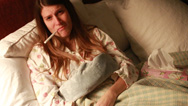What Really Causes Cavities?
- By Anna Rothschild
- Posted 01.28.16
- NOVA
Hate going to the dentist? Keep the millions of microbes in your mouth happy. Find out how in this episode of Gross Science.
Transcript
What Really Causes Cavities?
Posted: January 28, 2016
Did you know that you have whole communities of microbes living in your mouth right now? And if you don’t treat them right, they’ll make holes in your teeth.
I’m Anna Rothschild, and this is Gross Science.
No matter how much you brush, your mouth is filled with microbes. Thousands of bacteria live on every single one of your teeth—and that’s if you have excellent oral hygiene! You may even have some fungi and amoebas in there, too.
Which microbes are present changes all the time, based on, say, who you’re dating. We swap something like 80 million bacteria with every 10-second-long French kiss, and couples who live together tend to have similar microbes on their tongues. That said, there is what scientists call your “core microbiome.” That’s the 150-ish different species of microbes living in most people’s mouths.
Now, lots of these guys are totally harmless—and some are even helpful. For example, some microbes help keep you from getting thrush, which is a yeast infection of the mouth.
Increasingly, we’re learning that to have a healthy mouth we need healthy microbes, as well. In fact, cavities are a good example of what can happen when the balance of microbes in your mouth gets out of whack.
Many of the microbes living on your teeth form something called “plaque,” and in small quantities, these guys can be our friends. Plaque is what’s called a “biofilm”—essentially a community of different microbes that all stick to a surface, in this case, your teeth. The crazy thing is that these different microbes talk to each other, passing molecular signals back and forth, and swapping genetic material to keep on growing. Eventually, the community even develops what you could think of as a circulatory system to transfer water and nutrients.
And speaking of nutrients, the microbes in these biofilms need to eat, and one thing some of them really love is sugar. So, when you suck on a lollipop, you’re not the only one getting a tasty treat. After their meal, these candy and soda-hungry microbes release acid as a waste product. And that acid is what pulls out the minerals in your teeth, eventually causing cavities.
Now, if you stop eating sugary foods and clean off the plaque by brushing, your teeth have a chance to recover. But if, for example, you drink soda all the time, the bacteria just produce more and more acid, which not only causes cavities, but could actually kill off some of the other, good microbes hanging around. And as the balance of bacteria in your mouth changes, you could get even more tooth decay and other dental problems.
So what can you do about it? Don’t eat too many sugary foods, remember to brush and floss, and get regular cleanings from your dentist. Cause we need to keep our communities of microbes happy and healthy.
Ew.
Credits
PRODUCTION CREDITS
- Host, Writer, Animator, Editor
- Anna Rothschild
- Camera, Sound
- Katherine Hashimoto
- Many thanks to Drs. Susan Perkins, Rob DeSalle, and Anne Tanner
- Toy Box
- Music Provided by APM
- Original Footage ©WGBH Educational Foundation
FOOTAGE AND IMAGES
- Dental Plaque, SEM
- Steve Gschmeissner/Science Photo Library
- Dental Plaque Bacteria in Phase Microscope 600X Blue Filter
- Pond5/jamesbenet
- Lovers Kissing Romantic Romantic Beautiful Kissing Teens Couple in Hd
- Pond5/TH_Producties
- Elderly Couple Pond5/Fotoluminate
- Dental Plaque From Human Sample 800Z Microscope Pond5/jamesbenet
- Devan
- Flickr/Seth Lemmons
- Candida albicans 2
- Wikimedia Commons/GrahamColm
- Decayed wisdom tooth
- Wikimedia Commons/ProjectManhattan
- Dental cavity1
- Wikimedia Commons/Digantatalukdar
- Digital cavity2
- Wikimedia Commons/Digantatalukdar
- Double big gulp
- Wikimedia Commons/Russell Bernice from New York City, USA
- Plaque Disclosing Tablets
- Wikimedia Commons/Themolarbear
- File: Sugar Cubes (7164573186)
- Wikimedia Commons/david pacey from LEEDS, West yorkshire
- File: The Dental cosmos (1912) (14769050452)
- Wikimedia Commons/White, J.D. McQuillen, J.H. (John Hugh), 1826-1879. Ziegler, George Jacob, 1821-1895. White, James William, 1826-1891. Kirk, Edward C. (Edward Cameron), 1856-1933. Anthony, L. Pierce (Lovick Pierce), b. 1877.
- File: Phagocytose Entamoeba gingivalis-PMN
- Wikimedia Commons/Mark Bonner dmd, Institut International de Parodontie, www.parodontite.com
- Oral thrush. Aphthae. Candida albicans.
- CDC
SFX
- Dun dun dun
- Freesound/Simon_Lacelle
- Squeak Pack/squeak_10
- Freesound/Corsica_S
- Jelly/Jelly Mangling on Plate
- Freesound/lolamadeus
- Bubbles Popping
- Freesound/ch0cchi
- Produced by WGBH for PBS Digital Studios
POSTER IMAGE
- Microbes and Lollipop
- ©WGBH Educational Foundation 2016
Sources
Want more info?
Welcome to the Microbiome, by Susan Perkins and Rob DeSalle:
http://amzn.to/1PtAi3u
Kissing and the microbiome:
http://bit.ly/1PNCkFH
More on thrush from the CDC:
http://1.usa.gov/1KyxNp2
The Role of Bacteria in the Caries Process:
http://bit.ly/1PNDPDQ
Related Links
-

Gross Science
Bizarre stories from the slimy, smelly, creepy world of science.
-

What Are Tonsil Stones?
If you’ve got white lumps in your throat, they could be tonsil stones or “tonsilloliths.”
-

Build Your Own Microscope
See the creatures living in a puddle using your phone, poster tack, and a laser pointer.
-

Why Do You Get Sick After Exams?
Does it seem like every year you get sick the minute you start your vacation?

